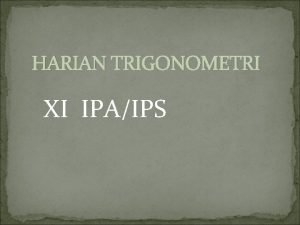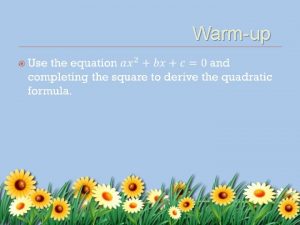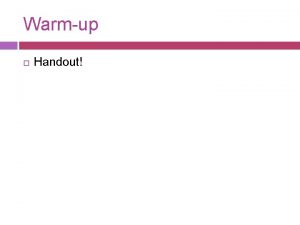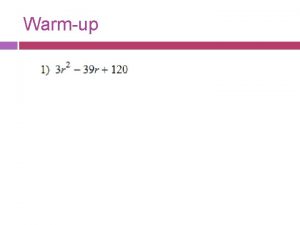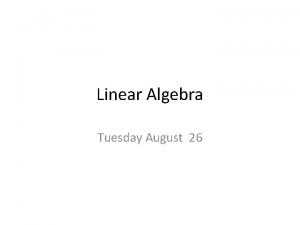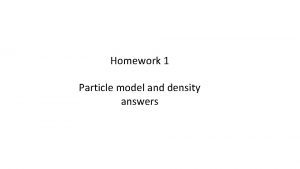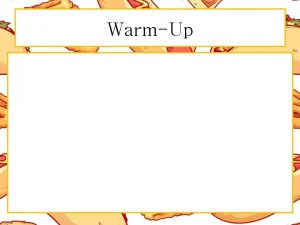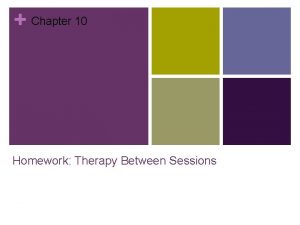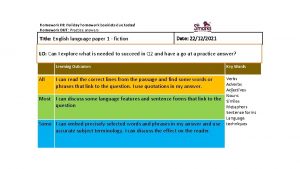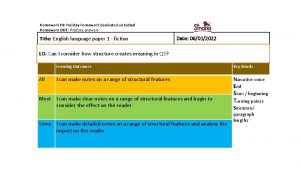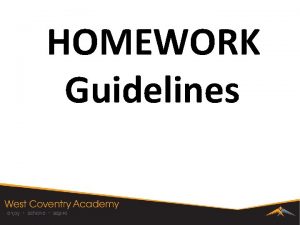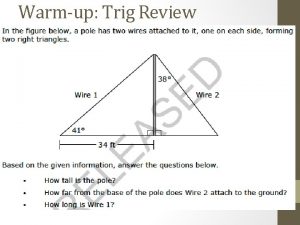Warmup Homework Answers 1 112 4 7 47



















- Slides: 19

Warm-up

Homework Answers 1) 1/12 4) ¼ 7) 47. 5% 10) Omit 11 c) 0 12 b) 1/20 2). 036 5) 1/16 8) 24 11 a) ¼ 11 d) 5/6 12 c) 0 3). 0029 6) 9/169 9) 360 11 b) 13/16 12 a) 1/10 12 d) 13/16

Compound Probability Kahoot! https: //play. kahoot. it/#/k/f 695 acd 7 -4 c 0 c-4 af 9 ac 9 d-98611 d 404934 Can also copy and paste this into Chrome

Warm-up 1) The standard deck of cards is shuffled and one card is drawn. Find the probability that the card is red or a jack? 2) The probability of a NY teenager owning a skateboard is. 37, of owning a bike is. 81 and of owning both is. 36. If a NY teenager is chosen at random, what is the probability that the teen owns a skateboard or a bike? 3) What is the probability of drawing 2 face cards one after the other without replacement?

Conditional Probability • Conditional Probability: A probability where a certain prerequisite condition has already been met. • For example: • What is the probability of selecting a queen given an ace has been drawn and not replaced. • What is the probability that a student in the 10 th grade is enrolled in biology given that the student is enrolled in CCM 2? • Video about Conditional Probability

Conditional Probability Formula • The conditional probability of A given B is expressed as P(A | B) = P(A and B) P(B)

Joint Probability P(A and B) A B S

Conditional Probability Since Event A has happened, the sample space is reduced to the outcomes in A A S P(A and B) represents the outcomes from B that are included in A

Using Two-Way Frequency Tables to Compute Conditional Probabilities • In CCM 1 you learned how to put data in a twoway frequency table (using counts) or a twoway relative frequency table (using percents), and use the tables to find joint and marginal frequencies and conditional probabilities. • Let’s look at some examples to review this.

1. Suppose we survey all the students at school and ask them how they get to school and also what grade they are in. The chart below gives the results. Complete the two-way frequency table: Bus Walk Car Other 9 th or 10 th 106 30 70 4 11 th or 12 th 41 58 184 7 Total

Bus Walk Car Other Total 9 th or 10 th 106 30 70 4 210 11 th or 12 th 41 58 184 7 290 Total 147 88 254 11 500 Suppose we randomly select one student. a. What is the probability that the student walked to school? • 88/500 • 17. 6% b. P(9 th or 10 th grader) • 210/500 • 42% c. P(rode the bus OR 11 th or 12 th grader) • 147/500 + 290/500 – 41/500 • 396/500 or 79. 2%

Bus Walk Car Other Total 9 th or 10 th 106 30 70 4 210 11 th or 12 th 41 58 184 7 290 Total 147 88 254 11 500 d. What is the probability that a student is in 11 th or 12 th grade given that they rode in a car to school? P(11 th or 12 th car) * We only want to look at the car column for this probability! = 11 th or 12 th graders in cars/total in cars = 184/254 or 72. 4% The probability that a person is in 11 th or 12 th grade given that they rode in a car is 72. 4%

Bus Walk Car Other Total 9 th or 10 th 106 30 70 4 210 11 th or 12 th 41 58 184 7 290 Total 147 88 254 11 500 e. What is P(Walk|9 th or 10 th grade)? = walkers who are 9 th or 10 th / all 9 th or 10 th = 30/210 = 1/7 or 14. 2% The probability that a person walks to school given he or she is in 9 th or 10 th grade is 14. 2%

4. The manager of an ice cream shop is curious as to which customers are buying certain flavors of ice cream. He decides to track whether the customer is an adult or a child and whether they order vanilla ice cream or chocolate ice cream. He finds that of his 224 customers in one week that 146 ordered chocolate. He also finds that 52 of his 93 adult customers ordered vanilla. Build a two-way frequency table that tracks the type of customer and type of ice cream. Vanilla Adult Child Total Chocolate Total

Vanilla Adult Chocolate 52 Total 93 Child Total 146 224 Vanilla Chocolate Total Adult 52 41 93 Child 26 105 131 Total 78 146 224 a. Find P(vanilla adult) = 52/93 = 55. 9% b. Find P(child chocolate) = 105/146 =71. 9%

Examples 1. You are playing a game of cards where the winner is determined by drawing two cards of the same suit. What is the probability of drawing clubs on the second draw if the first card drawn is a club? P(club) = P(2 nd club and 1 st club)/P(1 st club) = (13/52 x 12/51)/(13/52) = 12/51 or 4/17 The probability of drawing a club on the second draw given the first card is a club is 4/17 or 23. 5%

2. A bag contains 6 blue marbles and 2 brown marbles. One marble is randomly drawn and discarded. Then a second marble is drawn. Find the probability that the second marble is brown given that the first marble drawn was blue. P(brown blue) = P(brown and blue)/P(blue) = (6/8 x 2/7)/(6/8) = 2/7 The probability of drawing a brown marble given the first marble was blue is 2/7 or 28. 6%

3. In Mr. Jonas' homeroom, 70% of the students have brown hair, 25% have brown eyes, and 5% have both brown hair and brown eyes. A student is excused early to go to a doctor's appointment. If the student has brown hair, what is the probability that the student also has brown eyes? P(brown eyes brown hair) = P(brown eyes and brown hair)/P(brown hair) =. 05/. 7 =. 071 The probability of a student having brown eyes given he or she has brown hair is 7. 1%

Homework HW 8 -5 # 1 -5, 8, and 12
 Cos 112 5
Cos 112 5 Warmup ratio
Warmup ratio Warmup 65
Warmup 65 Gmass warmup
Gmass warmup Stratified warmup
Stratified warmup Pyramid warmup
Pyramid warmup Monorhyme
Monorhyme Multiplying exponents
Multiplying exponents Java warmup
Java warmup Define:warmup
Define:warmup Persuasive essay quotes
Persuasive essay quotes Tinman schwartz
Tinman schwartz 65 mins
65 mins Warmup end
Warmup end Homework oh homework
Homework oh homework Homework oh homework i hate you you stink
Homework oh homework i hate you you stink Parts of a poem
Parts of a poem Jack prelutsky homework oh homework
Jack prelutsky homework oh homework Alitteration definition
Alitteration definition When she sings her voice is like velvet
When she sings her voice is like velvet
